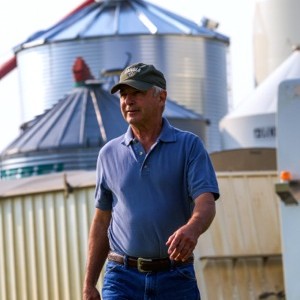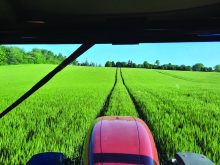Stan Jeeves runs a mixed farm near Wolseley, a southeastern Saskatchewan community once named one of Canada’s prettiest towns by Harrowsmith Country Life Magazine.
Jeeves takes a common-sense approach to selling grain. “I start with calculating my cost of production,” Jeeves says. “And then I know when I need cash flow.”
From there, Jeeves looks for delivery contracts that are above his cost of production and within the time frame when he wants the cash.
Read Also

The big squeeze: How to be fair to siblings during farm succession
Managing sibling business relationships on family farms.
It all sounds simple and natural, and a sure way for anyone to win in the markets every year. But that can be deceiving, as you learn the further you delve into Jeeves’ marketing systems and his belief in the critical importance of charts.
Farther east, Dale Gryba also focuses on a similarly practical approach. It isn’t that Gryba doesn’t know the more sophisticated lingo of marketing textbooks and the MBA schools. But, says Gryba, he doesn’t actually market his crop. He sells it.
“We are simply sellers above the cost of production,” says the Manitoba farmer. “Marketing,” he says, is done on behalf of farmers by organizations such as the Canadian International Grains Institute that differentiates the Canadian crop for world buyers.
Farmers are selling a commodity, Gryba says. They have few means of differentiating their crop from that in the bin down the road.
But that doesn’t mean Gryba thinks he always has to be a price-taker. In fact, avoiding market troughs comes down to taking charge — with a plan.
Know, and control, the critical numbers
Cost of production also underpins Gryba’s plan, helping him to sell at a price that covers costs and still gives him “a little bit of spare beer money.”
When it comes to managing costs, Gryba takes his cue from Ford Motor Company. “It knows its cost of production. And it knows what it can sell that car for. So it just makes it cheaper.”
Gryba pre-prices inputs, buying fertilizer in the fall, but acknowledges that takes cash. When cash flows have slowed to a trickle, cutting seeding costs is another option, Gryba says. “If you haven’t got much cash then you seed oats or the grasses… And hope for a Hail Mary.”
Gryba farms near Gilbert Plains, in the parkland of southwestern Manitoba, just a stone’s throw from the rail line. Loading producer cars also lowers Gryba’s costs. “We can get a dollar and a half more by putting wheat in a rail car versus going to the elevator for ourselves,” he says.
That discipline extends beyond controlling costs and knowing the numbers. Both Jeeves and Gryba put that self-control into action when selling by using commodity pricing charts.
Gryba took courses over 20 years ago, in the days when they had to handwrite their charts, and says knowing how to use the charts is magical. They take the guesswork out of unpredictable world events such as war or floods or droughts, he says.
“You can draw a line on a chart and watch it hit it,” says Gryba.
- More Country Guide: In control… ahead of the market
Jeeves and Gryba both say commodity charts take the emotion out of selling.
“People like to think this is all new — the commodity funds influencing the market and one thing and another — but the market has traded on weather and emotion forever and it always will as far as I can see,” says Jeeves. “So that’s where the charts come in.”
Jeeves also looks at commodity price charts and daily newsletters to figure out whether the price will climb or fall. He says the money tends to enter and leave the market at the same point. “So if you’ve seen the recent highs have been $450 in canola in the last three months, then next time it’s at $450 it’s probably a good idea to sell some,” he says.
Farmers need to avoid both fear-based selling and the temptation to try to catch the top of the wave. Holding out for the high point is essentially betting against industry, says Gryba, which is a losing strategy in the long run.
“If you did beat Cargill once or twice, it’s like Vegas,” says Gryba.
Gryba says farmers don’t have to have their entire crop priced out September 1, but they should have a large portion figured out at a price that will make them happy.
For example, if a farmer wants $10 for canola, “when canola hits $10, then you sell some at $10. You don’t wait until November when you and 40,000 other guys need money. Everybody knows (about) November 1 payments,” Gryba says.
“You’ve got 24 or 30 months to sell a crop,” says Gryba, who adds “there’s an old saying too that usually you have at least two opportunities to make a profit, even in a poor year.”
Dealing with the transportation snarl-up
Gryba compares the transportation issue to the dispute between hockey players and team owners.
And farmers aren’t the billionaires in this scenario, Gryba adds. “All I want to do is play hockey. Just let me over the bench, coach,” he says.
But it was pretty hard to play hockey this year. Producer cars ordered in January didn’t arrive in the Gilbert Plains area until August 5, Gryba says. March cars weren’t expected until the end of August or September. Farmers can’t deliver on a contract if the train doesn’t come, Gryba says.
Jeeves says the inability to move grain when needed forced farmers to give up the carry in the market.
“That’s been unfortunate and has cost producers money,” says Jeeves.
For his part, Jeeves wasn’t always able to sell crops when he needed cash flow this year.
“Fortunately, by having cattle that were very marketable, we were able to move our cattle marketing up some to cover off the lack of cash flow from grain,” he says.
Gryba also had an ace or two up his sleeve. He contracts high erucic acid canola with Bunge, which gives him peace of mind, he says.
“They give you a price in advance, a year ahead. And they take all you can grow,” says Gryba, adding the canola is delivered to a crushing plant in Nipawin, Sask. Bunge generally takes portions of the crops throughout the year, and offers a cash advance program, Gryba says. The contract also includes an Act of God clause.
Gryba would like to see the industry offer more Act of God clauses in delivery contracts. He points out big farms with, for example, 10,000 acres can risk pre-selling more of their contract without such clauses because they know they’ll likely get an average yield over their entire farm. But farmers with less dirt are reluctant to sign such contracts because of hail and other weather risks.
Although big farms might have an advantage when it comes to spreading risk on pre-pricing contracts, bigger isn’t automatically better, says Gryba. It still comes down to management and having a plan, he says.
“Forget about selling everything at the highest — it isn’t going to happen. It’s not getting caught in the bottom third all the time,” says Gryba. “If you have a plan, you won’t be in that bottom third.”
Jeeves jokes that staying in business is perhaps a measure of success. “Self-evaluation is always a tough criteria to meet,” he says.
Ultimately meeting targets, and avoiding scrambling and illogical decisions “because you’re in a corner because of financial pressures” are signs of a solid marketing plan, says Jeeves.

















